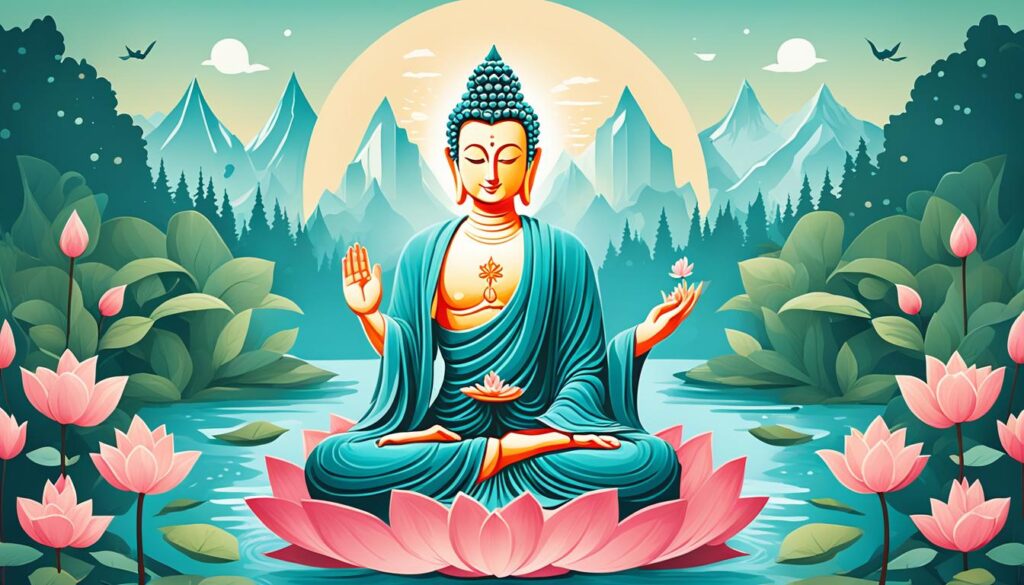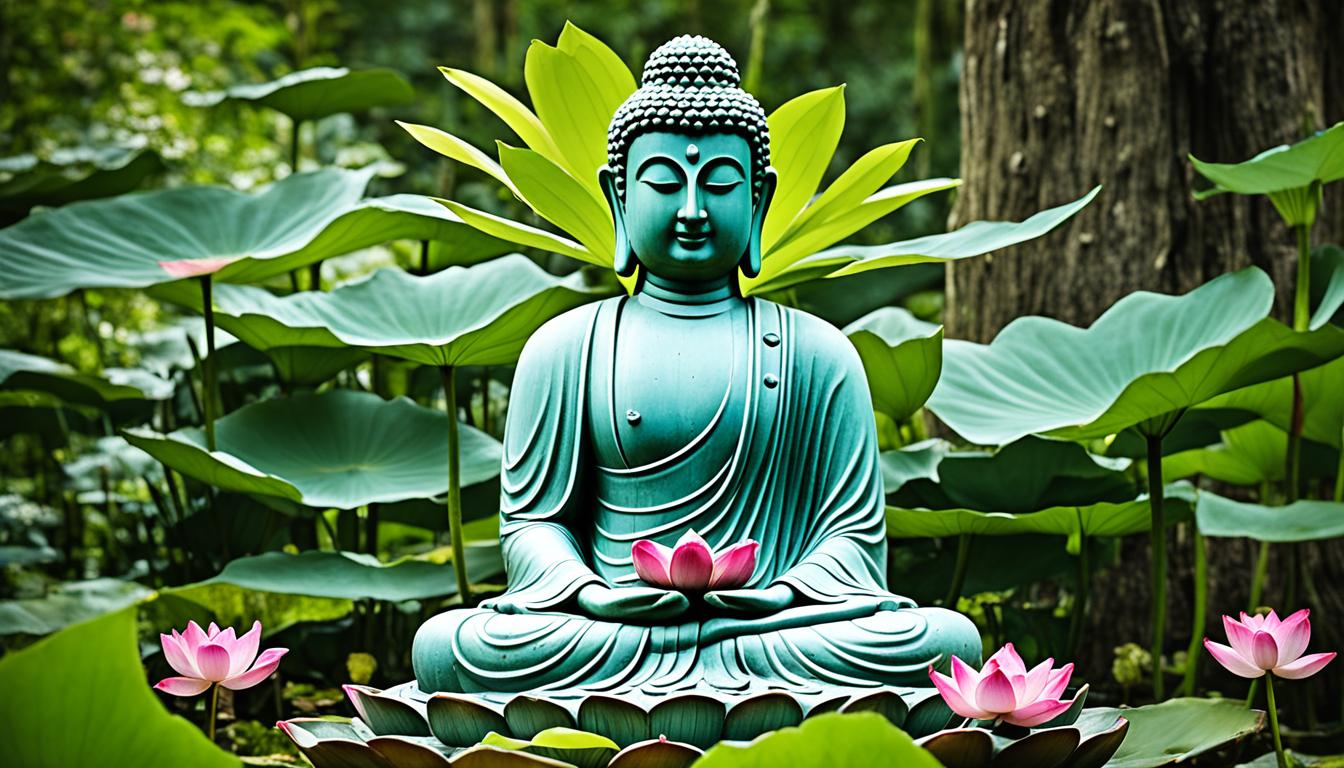“The mind is everything. What you think, you become.” – Buddha
Welcome to a journey of self-discovery and enlightenment. Buddhism, an ancient and profound belief system, offers a unique perspective on the human experience and the path to inner peace. With over 2,500 years of history, Buddhism has captivated millions worldwide, guiding them towards a deeper understanding of their own minds and the world around them. As you delve into the world of Buddhism, you will uncover profound truths, timeless wisdom, and practices that can transform your life.
Buddhism is not just a religion; it is a philosophy, a way of life rooted in compassion, mindfulness, and self-reflection. At its core lies the understanding that suffering is an inseparable part of human existence. However, Buddhism offers a pathway to liberation from suffering and the attainment of enlightenment – a state of profound inner peace, wisdom, and compassion.
Join us as we explore the key beliefs, principles, and practices of Buddhism, unveiling the rich tapestry of this remarkable spiritual tradition. Discover the teachings of the Buddha, the development of Buddhism throughout history, the different traditions, and the practical application of Buddhist principles in daily life. Through this exploration, you will gain insight into the profound impact that Buddhism can have on your personal growth, relationships, and overall well-being.
Key Takeaways:
- Buddhism is a non-theistic faith founded by Siddhartha Gautama, the Buddha.
- The ultimate goal of Buddhism is to achieve enlightenment and inner peace.
- Central beliefs of Buddhism revolve around suffering and its causes.
- Buddhism encompasses various traditions and interpretations, including Theravada, Mahayana, and Tibetan Buddhism.
- Buddhism provides guiding principles for daily life, such as mindfulness, ethics, and meditation.
Key Beliefs and Principles of Buddhism
In Buddhism, there is no belief in a supreme deity. Instead, the focus is on achieving enlightenment, a state of inner peace and wisdom that leads to liberation from suffering. The path to enlightenment involves morality, meditation, and wisdom, and Buddhists strive to cultivate these qualities in their daily lives. Buddhism is a tolerant and evolving religion, with various philosophies and interpretations that cater to individual needs and preferences.
Central to Buddhist teachings are the Four Noble Truths, which provide insights into the nature of suffering and its cessation:
- Dukkha: The truth of suffering, acknowledging the inherent dissatisfaction and impermanence of existence.
- Samudaya: The truth of the origin of suffering, recognizing desire as the root cause of human suffering.
- Nirodha: The truth of the cessation of suffering, revealing that liberation from suffering is attainable.
- Magga: The truth of the path to the cessation of suffering, offering a roadmap for achieving enlightenment through ethical conduct, meditation, and wisdom.
Additionally, Buddhism embraces the concepts of karma and reincarnation. Karma refers to the law of cause and effect, where one’s actions in this life directly influence their future experiences. Reincarnation, on the other hand, entails the continuous cycle of rebirth, where beings are born into new forms based on their actions in previous lives.

Buddhist Teachings and the Pursuit of Enlightenment
Buddhists can pursue enlightenment through self-reflection, meditation, and the study of Buddhist scriptures. These teachings often provide guidance on ethical conduct, compassion, mindfulness, and achieving a deep understanding of the nature of reality. By following the teachings of the Buddha, individuals can develop wisdom, cultivate inner peace, and ultimately attain liberation from suffering.
Buddhists have the freedom to practice their faith in various settings, such as temples, monasteries, or in the comfort of their own homes. Temple visits may involve engaging in rituals, making offerings, and seeking guidance from ordained Buddhist monks and nuns. These spiritual leaders play an essential role in upholding the teachings and providing guidance to the Buddhist community.
Founding and Development of Buddhism
Buddhism, one of the oldest religions in the world, traces its roots back to Siddhartha Gautama, also known as “the Buddha.” Born into a wealthy family in present-day Nepal during the 5th century B.C., Gautama lived a life of luxury. However, he became disillusioned with the material world and embarked on a spiritual quest to discover the meaning of life and alleviate human suffering.
After years of self-discipline and meditation, Gautama achieved enlightenment while meditating under a Bodhi tree. This profound experience marked the birth of Buddhism and transformed Gautama into the Buddha, or the “Awakened One.”
The Buddha spent the rest of his life teaching others about his insights and principles, which formed the foundation of Buddhism. He emphasized the Four Noble Truths, the fundamental teachings that address the nature of suffering and its cessation.
Buddhism began to spread beyond India during the Buddha’s lifetime, as his teachings resonated with many people seeking spiritual guidance. Different traditions and interpretations of Buddhism developed as it transcended cultural boundaries and gained followers in various regions.

Today, Buddhism encompasses a rich tapestry of beliefs and practices, influenced by cultural and societal contexts. Various Buddhist traditions, including Theravada Buddhism, Mahayana Buddhism, and Tibetan Buddhism, have emerged, each with its own distinctive characteristics and philosophical viewpoints.
While Theravada Buddhism prevails in Southeast Asia, Mahayana Buddhism is popular in East Asia, and Tibetan Buddhism is practiced in Tibet and surrounding regions. Each tradition reveres certain scriptures and places emphasis on particular practices.
Buddhism’s journey from its humble origins to a global religious tradition is a testament to its enduring appeal and relevance. The teachings of the Buddha continue to inspire countless individuals to seek enlightenment, cultivate compassion, and live harmoniously with themselves and the world around them.
Influential Figures in the Development of Buddhism
| Name | Role | Significance |
|---|---|---|
| Ashoka | Emperor of Maurya Empire | Played a crucial role in the spread of Buddhism across India and beyond through his patronage and promotion of the religion. |
| Atisha | Buddhist teacher | Revived Buddhism in Tibet during the 10th century and laid the foundation for the development of Tibetan Buddhism. |
| Avalokiteshvara | Bodhisattva of compassion | Highly revered figure in Mahayana Buddhism, embodying the compassionate ideal and offering guidance and support to practitioners. |
| Tsongkhapa | Scholar and philosopher | Founded the Gelug school of Tibetan Buddhism, known for its emphasis on monastic discipline and rigorous study. |
Different Traditions and Practices in Buddhism
Buddhism is a diverse and vibrant religion, practiced in various forms around the world. Different regions have developed their own unique traditions and interpretations of Buddhist teachings. Let’s explore some of the main types of Buddhism and their distinctive practices.
1. Theravada Buddhism
Theravada Buddhism, also known as the “Way of the Elders,” is prevalent in Southeast Asia, including countries like Thailand, Myanmar, Sri Lanka, and Cambodia. This tradition adheres closely to the original teachings of the Buddha and places emphasis on personal liberation through wisdom and meditation.
Key Features:
- Theravada monks follow a strict monastic code of conduct called the Vinaya.
- The Tripitaka, a collection of the Buddha’s teachings, is highly revered.
- Individuals strive to attain enlightenment and achieve nirvana—the ultimate goal of Theravada Buddhism.
2. Mahayana Buddhism
Mahayana Buddhism, popular in East Asian countries such as China, Japan, and Korea, is characterized by its inclusive and compassionate approach. Followers of Mahayana Buddhism seek to benefit all beings on their journey towards enlightenment.
Key Features:
- Mahayana tradition recognizes numerous celestial beings known as bodhisattvas who assist individuals in their quest for enlightenment.
- Texts like the Lotus Sutra and the Heart Sutra hold significant importance.
- Devotional practices, such as chanting and ceremonies, play a crucial role in Mahayana Buddhism.
3. Tibetan Buddhism
Tibetan Buddhism, practiced in Tibet, Nepal, Bhutan, and other regions of the Himalayas, is a rich blend of Tibetan culture and Buddhist philosophy. This tradition encompasses a wide range of practices and rituals aimed at spiritual development.
Key Features:
- Tibetan Buddhism places importance on the spiritual guidance of lamas, experienced teachers who provide instruction and transmit sacred teachings.
- The Tibetan Buddhist canon includes translated Indian Buddhist scriptures and indigenous texts like the Kangyur and Tengyur.
- Mantras, prayer flags, and intricate sand mandalas are integral aspects of Tibetan Buddhist rituals.
4. Zen Buddhism
Zen Buddhism, derived from the Chinese Chan tradition, focuses on direct experience and intuitive understanding. Zen practitioners seek sudden enlightenment through rigorous meditation and mindfulness practices.
Key Features:
- Zen emphasizes seated meditation (zazen), often practiced in a cross-legged lotus position.
- Teachings are often transmitted through direct, unmediated encounters between teacher and student.
- Koans, paradoxical statements or questions, serve as a means of provoking deep insight and breaking through conceptual thinking.
5. Other Buddhist Traditions
In addition to the aforementioned traditions, Buddhism has evolved and adapted to various cultural contexts, leading to the development of other forms of practice influenced by local beliefs and philosophies. For example:
- Nichiren Buddhism, founded by the Japanese monk Nichiren, emphasizes chanting the mantra “Nam-myoho-renge-kyo” as a means of attaining enlightenment.
- Engaged Buddhism, inspired by the teachings of Vietnamese monk Thich Nhat Hanh, promotes active involvement in social and environmental issues as a form of spiritual practice.
While these traditions have unique characteristics, they all share the common aim of alleviating suffering and attaining enlightenment. Each form of Buddhism offers a distinct pathway for individuals to cultivate mindfulness, compassion, and wisdom.

Comparison of Main Buddhist Traditions
| Tradition | Main Regions | Key Texts | Emphasis |
|---|---|---|---|
| Theravada | Southeast Asia | Tripitaka (Pali Canon) | Personal liberation and monks’ disciplined lifestyle |
| Mahayana | East Asia | Lotus Sutra, Heart Sutra, Avatamsaka Sutra | Compassion, bodhisattva path, and devotion |
| Tibetan | Tibet, Himalayan regions | Kangyur, Tengyur | Devotional rituals, spiritual guidance of lamas |
| Zen | China, Japan, Korea | Zen teachings, koans | Direct experience, meditation, and intuitive understanding |
Buddhist Principles for Daily Life
When it comes to navigating life’s challenges and pursuing personal growth, Buddhism offers invaluable principles and practices. By incorporating these teachings into your daily life, you can cultivate inner peace, ethical conduct, and a deeper sense of purpose. Here are some key Buddhist practices that can guide your journey:
Mindfulness
At the heart of Buddhist practice lies the art of mindfulness. Mindfulness involves being fully present in the moment and developing awareness of your thoughts, emotions, and actions. By practicing mindfulness, you can develop a deep sense of self-awareness and break free from patterns of reactivity and unconsciousness.
The Five Precepts
The Five Precepts form the ethical foundation of Buddhist life. These precepts serve as guidelines for ethical conduct and encompass refraining from killing, stealing, sexual misconduct, lying, and using drugs or alcohol. By adhering to these principles, you cultivate compassion, integrity, and respect for all living beings.
Meditation
Meditation is a core practice in Buddhism and plays a significant role in cultivating inner peace, concentration, and insight. Through regular meditation, you can develop a calm and focused mind, enhance self-awareness, and deepen your understanding of the nature of reality.
Rituals and Ceremonies
Buddhists often engage in rituals and ceremonies to express devotion, gratitude, and reverence. These rituals can vary depending on the Buddhist tradition, but they generally involve offerings, chanting, and symbolic gestures. Participating in such rituals can deepen your spiritual connection and create a sense of sacredness in everyday life.
By incorporating these practices into your daily life, you can cultivate a greater sense of inner peace, compassion, and ethical conduct. Embracing the wisdom of Buddhism allows you to navigate life’s challenges with clarity and grace, fostering personal growth and spiritual fulfillment.

| Buddhist Practices for Daily Life | |
|---|---|
| Mindfulness | Developing self-awareness and living in the present moment |
| The Five Precepts | Guidelines for ethical conduct and compassionate living |
| Meditation | Cultivating inner peace and insight through regular practice |
| Rituals and Ceremonies | Expressing devotion, gratitude, and reverence through symbolic acts |
Conclusion
Buddhism offers profound insights into the nature of existence, suffering, and the path to liberation. Its teachings on mindfulness, compassion, and ethics have become increasingly relevant in addressing modern challenges and promoting personal and societal harmony.
Through buddhism meditation and the study of buddhist scriptures, individuals can embark on a transformative journey toward inner peace and enlightenment. Meditation allows you to quiet the mind, cultivate self-awareness, and develop a deep sense of presence. It is a powerful tool that helps you let go of stress and anxiety, nurturing a calm and balanced state of being.
The buddhist scriptures, such as the Tripitaka and the Mahayana Sutras, contain the wisdom and teachings of the Buddha. Reading and contemplating these sacred texts can provide guidance and inspiration on the path to enlightenment. The scriptures delve into profound philosophical concepts, offering practical insights into the nature of reality, impermanence, and the interconnectedness of all beings.
By applying Buddhist principles in your daily life, such as practicing compassion, cultivating mindfulness, and upholding ethical conduct, you can foster a deeper understanding of yourself and the world around you. Embracing the religious beliefs of Buddhism can nurture a sense of connection, empathy, and spiritual fulfillment, enhancing your overall well-being. Buddhism’s enduring impact is evident in its continued growth and influence across cultures and continents, inspiring individuals to embark on a transformative journey of self-discovery and inner peace.
FAQ
What is Buddhism and what are its religious beliefs?
Buddhism is a non-theistic faith founded by Siddhartha Gautama, also known as “the Buddha,” over 2,500 years ago in India. Its beliefs revolve around the concept of suffering and its causes, with the ultimate goal of achieving enlightenment and inner peace.
How did Buddhism originate and develop?
Buddhism was founded by Siddhartha Gautama during the 5th century B.C. After attaining enlightenment, Gautama spent his life teaching others about his insights and principles, which became the foundation of Buddhism. Over time, Buddhism spread beyond India, with different traditions and interpretations developing.
What are the different traditions and practices in Buddhism?
Buddhism is practiced in different forms around the world. The three main types are Theravada Buddhism, Mahayana Buddhism, and Tibetan Buddhism, each with slightly different interpretations of Buddha’s teachings. Other forms of Buddhism, such as Zen Buddhism and Nirvana Buddhism, also exist.
What are the key principles and teachings of Buddhism?
Buddhism emphasizes cultivating morality, mindfulness, and meditation. Buddhists strive to engage in right speech, right action, and right livelihood. The Four Noble Truths, the concept of karma, and the Precepts are central to the teachings of Buddhism.
How does Buddhism guide daily life and ethics?
Buddhists strive to lead a compassionate and ethical life by cultivating morality, mindfulness, and meditation. They follow the Precepts, which include refraining from harmful actions such as killing, stealing, lying, and using drugs or alcohol. Buddhist rituals and ceremonies are also observed as expressions of devotion and gratitude.
What are the main practices and rituals in Buddhism?
Buddhism places a strong emphasis on meditation as a means to cultivate inner peace and clarity of mind. Buddhists also engage in studying Buddhist scriptures, observing rituals and ceremonies, and following the teachings of Buddhist monks to deepen their spiritual practice.

